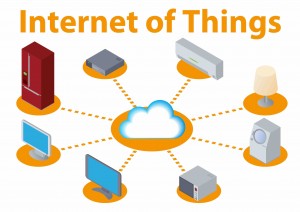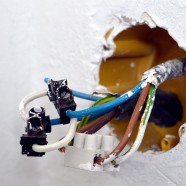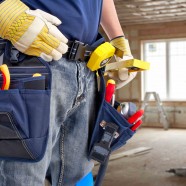Reasons to Replace Older Electrical Wiring in Your Home
As long as the lights are shining and the air conditioning is working, most people don’t give the wiring in their home a second thought. Unless you’re the original owner of your house, you’ve got no way of knowing everything you should about the electrical system in your home. Electricians tend to replace what’s needed and worn out, leaving the rest behind in a piecemeal fashion. The result is usually a mixture of old and new wiring with varying abilities to run the appliances you have in your rooms. Replacing the older electrical wiring might be an obvious choice once you start having problems, but there are reasons to renew your system before you start to see troubles.
Room Renovation
When you’re redoing a room in your home, it’s the perfect time for an electrical renovation. Contractors will be knocking down interior walls and making over the interior of your home, why not improve the workings inside as well? It’s the easiest time to replace electrical wiring, since your contractor won’t have any wallboard in the way, and it’s much simpler to find out the condition of the wiring that’s already installed.
Fire Hazards
Worn electrical wiring is one of the most common causes of house fires. If the electrical wiring in your home is cracking, fraying, or falling apart in some other way, the exposed wires cause a real danger of sparking and catching home materials on fire. Here are some of the most common warning signs:
- Frayed wires with the covering cracked or broken and the interior wiring exposed
- Outlet scorch marks. Outlet covers should be cool to the touch. Warm or hot spots usually mean a short in the wire behind the outlet plate.
- Dimming lights when you plug in the vacuum or use the microwave
- Rodent problems. If you’ve had trouble with mice or rats, take the time to inspect your wiring. Rodents love to chew on the coverings of residential electrical wiring
- Circuit breakers tripping. Once is an annoyance. Multiple times means your wiring isn’t up to handling the load you’re asking it to carry
Economics
If you’re going to have your wiring replaced, doing it during a home renovation is the least expensive time frame in which to do it. You won’t have to pay for any demolition needed to get to the wires, and wall repairs have already been budgeted. Upgrading your wiring to a more modern system can save you money in other ways, too. Upgraded systems with the correct amount of outlets can handle home usage easier and will send fewer surges through the system. This can save you thousands of dollars in computer costs if you don’t have an upgraded surge protector installed.
Modern Usage
Think about the electrical appliances you use every day compared to even 10 or 20 years ago. Today’s family typically has at least one computer that runs almost all day as well as HDTVs, elaborate stereo systems, smart appliances, and other belongings that use electricity in increasing amounts. Older wiring was never made to handle these loads, and will short out if asked to cover these loads for any period of time. Upgraded circuit breakers will handle overloads and surges, which additional lines and dedicated systems provide extra computing power for families with multiple work stations for work and school research.
Read MorePurpose and Value of Dedicated Electrical Circuits in Business
Running your business on one complete line is something like making a stew: all the components are mixed together, even if you want to treat one part in a special way. Business owners have been installing dedicated electrical circuits for as long as they’ve been relying on computers for their business needs. As computer technology has improved, so has electrical systems installed into businesses. Any kind of machinery that uses large amounts of power can benefit from a dedicated circuit, but they’re most common for computers and their components.
What a Dedicated Circuit Does
All the wiring in a building usually run together, meeting up at the circuit breaker box. This means the breakers service all electrical usage in the building equally. A dedicated circuit is a separate set of wires and a separate breaker box that only service one particular piece of equipment, most usually a computer or group of computers. This method of wiring insulates the computers in the building from every other piece of equipment, giving you a certain amount of electrical protection. Power fluctuations and overloaded circuits in one system don’t necessarily impact the other one, and electrical repairs are simpler to do because of the minimal amount of wiring to be dealt with.
Benefits of a Dedicated Circuit for Electrical Protection
The main reason for installing a dedicated circuit into your computer area is for electrical protection. Computers are more likely to be damaged by problems with the electrical system, so it’s smart to isolate them into one protected area. Some of the beneficial results of this installation are:
- Higher productivity. Computers will be up and working with fewer glitches and less down time
- Reduced electrical noise. When computers are on general circuits, the simple act of plugging in a vacuum cleaner or turning on a fan can cause fluctuations in the flow of electricity. With a dedicated circuit, you’ll avoid the possibility of these problems
- Reduced risk of electrical fires. Circuits that glitch out can spark and cause fires. Having less power running through each system reduces your fire risk throughout your business. This electrical protection goes for walk-in refrigerators, large air conditioners, oxygen pumps, or any other large piece of equipment that uses a lot of power.
- Less risk of data loss. If you keep your business records in one computer or set of computers, you’re at risk of losing crucial data when you leave your system open to surges and glitches. Isolating the computers into a dedicated circuit can help to protect your important information
Installing a New Dedicated Electrical Circuit
The best time to consider installing dedicated electrical circuits is when you’re putting up a new building or renovating an old one. It’s much simpler to install commercial electrical lines when the walls are already gutted and the joists are exposed. It’s possible for electrical installation to happen after the walls have been put up, though. Setting up a new dedicated commercial electrical system is a job for a commercial professional; sit down with your local licensed electrician and map out your wiring plan together. Much like other forms of insurance, it’s a smart move to have it even if you never need it.
Read More5 Tips for Cleaning Up After an Interior Fit-Up
An interior fit-up makes good business sense. Instead of doing every individual job piecemeal, getting it all done in one sweep will keep your business closed for the shortest amount of time and interrupt the fewest number of days for you and your employees. Even business owners facing new construction benefit from this business-building plan. If your fit-up included electrical installation, and most do, you’re probably left with a large mess to deal with before you can reopen your doors. It’s not just a matter of throwing out the trash. This mess needs special attention.
Disposing of the Dust
If you think dust is just an annoying film that coats your store shelves, you’ve never dealt with the aftermath of an electrical installation. This dust will coat every surface, and stays suspended in the air until you get rid of it. Begin by changing the air filters in your HVAC unit. This is the first line of defense against redeposited dust. Check the filter each day and change it again as soon as it’s needed. Walls are just as likely to harbor dust as floors or shelving. Moisten a towel and wrap it around a broom head, and use the broom to wipe dust from wide expanses of walls. Keep the towel just barely moist to avoid damaging any fresh paint that may have been added.
Livening up the Light Fixtures
The light fixtures are sure to be coated in dust and debris, even if they’ve been newly installed. Use a three-step ladder or other safe device to reach the top of each lighting fixture to remove the dirt. Any soil you knock free will fall onto the dirty room interior, so don’t worry about collecting this or using special tools.
Freeing the Floor of Debris
By this time, you’ve got a floor covered in dirt, dust, and broken materials. Work your way in from the outer edges, picking up the heaviest and bulkiest objects first. This is when the most danger lurks; broken glass, bare wires, and bent nails can be hiding among bits of wallboard or insulation. Use heavy work gloves when picking up discarded objects, or push them outside with a broom or shovel. Once the major pieces of garbage have been removed, sweep the floor. Do it once with a commercial push broom to get rid of the most obvious mess, then move on to a smaller broom or soft dry mop to pick up any remaining dust. Mop the floor, paying close attention to the corners, to finish the floor job.
Inspect Furniture and Appliances
Even if you’ve covered the furniture, a fit-up with electrical installation is such a major piece of work that dust and debris are likely to have worked their way into multiple odd places. Vacuum all the couches, side chairs, and desk chairs. Open all desk drawers and filing cabinets to make sure stray nails or debris haven’t fallen inside. Make a thorough search of the interior of any coffee makers, microwave ovens, or other small kitchen appliances you may have. While dust on the floor is annoying, dirt in your coffee maker can be physically dangerous.
Final Inspections
Once the interior of your business is clean, it’s a great idea to walk through and make sure all the electrical renovations work like you’d planned they would. Turn switches on and off, check every wall outlet with a lamp or other small appliance, inspect lighting fixtures or exit lights that may have been installed to make sure they are cleanly finished and work as expected. Turn on any large equipment such as air compressors or freezers to make sure the power is flowing to them and that they work.
Read MoreImportance of Emergency Exit Signs in Business Premises
The emergency exit signs and lights are among the most important parts of your building’s safety system. In the event of a fire or other building emergency, people can’t always rely upon their personal knowledge when it comes to finding their way outside. Strangers to the building won’t know the best exit routes, and even those familiar with the building layout can become confused. Exit signs and lights have to be bright and clear, able to be viewed through smoke and in darkness. They’re a crucial item on your regular electrical maintenance list.
Regulations
State and federal regulations cover the electrical safety features in your business, and this includes any exit signs and lights attached to them. According to the federal government, signs must be at least 6 inches tall with letters at least 2 inches wide, except the letter “I.” Signs have to be illuminated by a reliable light source. In order to comply with this ruling, most lights are wired to a standby generator to ensure the power to the sign stays on, even during a blackout.
Inspections
Regular inspections ensure that emergency exit signs point in the right direction and remain lit during any emergencies. Electrical maintenance schedules should include changing any light bulbs associated with the sign, both internal and external, as well as inspecting and maintaining the emergency power supply attached to these lights. This may include topping off fuel tanks, lubricating moving parts, or even cleaning the environment around the generator itself. Signs should be securely affixed to the walls, and inspectors should check screws or other fasteners to make sure they haven’t begun to come loose. The law says that all emergency exit signs should be capable of being illuminated for at least 90 minutes without going out. A regular inspection will test this and repair any lights that don’t comply with this ruling.
Placement
The placement of your exit signs is a crucial part of their design. Legally, they have to be no less than 80 inches above the floor to the bottom of the sign. Great care should be taken that the sign isn’t obstructed by any object in any direction. Check nearby doors and other moving objects to make sure they don’t cover the signs at any time. Additional exit signs should be attached next to the door latch, and a sign in Braille should be provided. If you have any large doors in your business building that look like they may be exit doors, regulations say that you have to post a sign stating that this is not an exit.
Benefits
Illuminated exit signs may offer an obvious benefit of pointing the way outdoors during a fire, blackout, or other emergency, but they have secondary benefits, as well. Insurance companies can give discounts to businesses that are compliant with safety regulations. Local governmental authorities sometimes have the power to levy fines and punishments if you don’t comply with the laws. Also, in case of any type of emergency, having abundant lighted exit signs all over your business can help to prevent frivolous lawsuits after the fact. Unfortunately, people will sue for almost any reason, and any evidence you have that can prove you took logical precautions is a large point in your favor.
Read MoreWhat’s the TRUE Cost of a Hurricane for a Homeowner?
Hurricanes are something that every resident in southeast Florida needs to take seriously. Living through a hurricane is a distinct possibility every year, and each May meteorologists predict deadlier storms for the area during the coming hurricane season. Traditional television coverage shows news reporters standing dramatically in front of ragged palm trees swaying in the wind, but losing your landscaping is the least of your worries during these storms. Florida residents face devastating losses from each hurricane, but you can prevent most of the damage by planning ahead and installing protection from power failures.
Loss of Power
During the worst of the storms, the first thing to happen is usually an electrical power failure. Losing power means different things for everyone, but at the very least it endangers food in refrigerators and lives in terms of needed medical machinery. Some things, like the loss of lights and televisions, can be seen as minor inconveniences. They’re easily dealt with by using alternate means such as candles and lanterns for lights and battery-operated entertainment devices. On the other hand, losing power to your refrigerator and freezer can mean losing hundreds of dollars worth of meat and produce. Losing your internet can mean huge losses at your job. And loss of electrical power can be life-threatening if you depend on oxygen tanks or refrigeration for your medication.
Safeguarding Power
The best way to ensure you won’t suffer from damage during an electrical power failure is to install a standby home generator. The size of generator you need depends on the size of your house and the amount of power you feel you absolutely need during the outage. You may be able to get by with the refrigeration and lights afforded by a smaller unit. On the other hand, if your health requires you to stay in a cool and dehumidified environment, you’ll need a larger unit that’s capable of running your central air conditioning unit. All units run in a similar manner, and they all have to be maintained monthly, but you decide how much power you really need during an outage.
Lightning Strikes
Hurricanes aren’t just wind and rain storms. They can create some intense lightning in a state that’s already number one in the country for strikes. Adding lightning protection to your home can mean the difference between a frightening noise and a serious fire hazard. Lightning strikes hundreds of buildings each year in Florida. Have your local electrical contractor install lightning protection in the form of air terminals, or lightning rods, to the roof of your home. If lightning does strike nearby, the electrical power will be diverted safely into the ground nearby, passing up your home. You’ll eliminate the fire hazard and the resulting electrical surges that can come with uncontrolled lightning.
Power Surges
Another danger from lightning storms or any type of electrical disturbance is electrical surges in your system. Most modern homes have multiple televisions, plus stereo systems and one or more computers in the house. Electrical surges can fry all the delicate electronics in your home if you’re not prepared with serious surge protection. You’ll need an updated breaker box in good condition, as well as surge suppressors that cut the power before surges can reach your electrical equipment. Since many instances of electrical power failure start off with a large surge of electricity that damages the power grid, having surge protection is a natural next step when it comes to protecting your home from the damage that hurricanes can cause.
Read MoreHow the Internet of Things Will Affect Residential Electrical
 Think of a home that cools the air when you walk in the door, that makes a grocery list for you based on the food you take from the refrigerator, and that turns your sprinkler off and on depending on the local weather reports. This home of the future is now, and it’s based on a concept called the Internet of Things. It’s the basis of houses called “smart homes”: a super-connected network of appliances and systems that run as one smooth process to make your life more comfortable, save energy, and be frugal, all at the same time.
Think of a home that cools the air when you walk in the door, that makes a grocery list for you based on the food you take from the refrigerator, and that turns your sprinkler off and on depending on the local weather reports. This home of the future is now, and it’s based on a concept called the Internet of Things. It’s the basis of houses called “smart homes”: a super-connected network of appliances and systems that run as one smooth process to make your life more comfortable, save energy, and be frugal, all at the same time.
Electrical Costs
Homes with advanced residential electrical systems will eventually base their cost and usage on the time the electricity turns on, as well as the amount of power used. Electricity is more expensive to produce during the middle of a hot summer day than on a fall evening. Electrical usage costs should be based on the actual cost of producing this power, not an average cost over the length of the month. If you’re frugal and only use lights at night when needed and keep your air conditioning usage to a bare minimum, you should be able to reap the benefits of that frugality. With the Internet of Things, a home’s electrical system will be so connected that you’ll see energy savings on a daily basis simply because of the way you use your utilities.
Smart Appliances
The idea of finding energy savings simply by timing your dishwasher and dryer loads may seem too complicated, but with smart technology it will be a basic part of running the appliances. When electrical power is cheaper in the evening or in the middle of the night, large appliances will have settings allowing you to fill them and then pause the action until later in the day. Your clothes and dishes will still be clean tomorrow, but you’ll use much cheaper power for doing the same job. Household chores will no longer be solely the province of someone filling time during an off day. It will be natural for everyone to fill and set machines, since it will be more important to have them run later than to have the work done at the certain time during the day.
Air Conditioning
A good part of energy conservation in south Florida depends on air conditioning usage for a great part of the year. More than any other appliance, the air conditioning unit uses up power at an increasing pace as the year moves forward. The Internet of Things will include smart A/C units and thermostats connected to heat sensors in each room of the house. When the system finds a human body in one room, it can kick on and cool the air selectively to make that person comfortable. Once the residents leave the home for the day, a smart home system will shut down to use a minimum of power, creating energy savings for the duration of the day. Cooling the home later in the day when the residents are home will reduce power usage while still keeping everyone cool and comfortable.
Anticipation
The Internet of Things doesn’t just mean having a toaster and dishwasher that turn themselves off when you’re off to work. It’s an interconnected system that combines smart appliances, an intelligent utility system and a power grid that is responsive to power usage and able to ebb and flow with the environment as well as human usage. Homes with this type of system will notice when people haven’t been in the home for a day or two and will turn off the water heater to save power. It will automatically turn alarms on and off based on when body heat is present or absent in the building, and even email the utility company when power needs to be throttled down to the home when you’re on vacation. The Internet of Things is the use of technology in ways that achieve energy conservation, but it’s also about having a more comfortable and convenient lifestyle.
Read More





Recent Comments